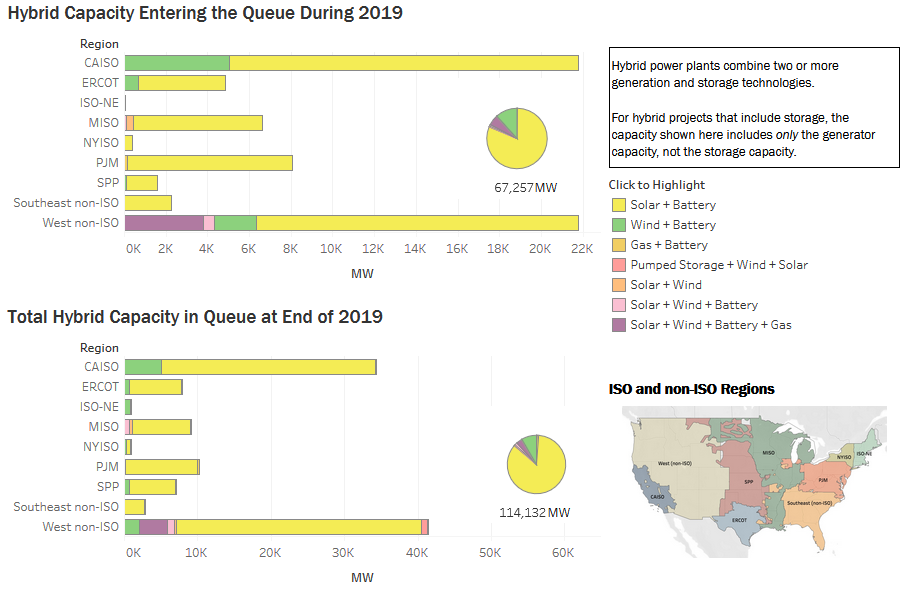Multi-Resource “Hybrid” Power Plants are the Present and Future of Energy Generation
By: Tyler Stoff
August 19, 2020
Single-resource power plants, like a field of solar panels or a hillside of wind turbines, are foundational to the modern renewable energy economy. They work well under the conditions of today’s grid. As renewable penetration increases, more complex projects can offer a new and expanded array of services, further enhancing the reliability and cost-effectiveness of grid operations. Hybrid power plants leverage the best qualities of generators with modern technology, such as energy storage, leading to smoother output and optimizing project economics.
A hybrid power plant is any combination of generation or storage resources paired together, such as solar or wind energy with energy storage. Hybrids leverage the unique qualities of different resource types to create new energy services at lower cost and greater reliability than single resource power plants. A hybrid that includes energy storage can shift the electrons generated by a variable power resource from times of surplus to times of need. It can level out changes in electrical frequency and voltage. A hybrid with more than one generator can ensure that it is always producing power from the most available, least costly fuel of the day, be that sunlight, wind or water.
The term hybrid can refer both to (1) “co-controlled” hybrids, where two or more resources offer their services to the grid operator as a single resource and to (2) “co-located” hybrids, where two or more resources offer their services at the same point of grid interconnection but present to the grid operator as multiple resources.
Rapid Growth
Fueled by declining costs, improving technology and favorable policies, hybrid energy resources have been on an upswing. According to a new analysis from Lawrence Berkeley National Laboratory, hybrid development proposals more than tripled between 2018 and 2019, representing over 100 gigawatts (GW) of capacity.

Of the hybrid resource combinations in interconnection queues, solar energy coupled with energy storage is the most popular combination. In fact, of the utility-scale solar projects in interconnection queues, nearly one-third are paired with energy storage. Solar-plus-storage pairings are common because of policy decisions made by Congress. Solar projects are currently eligible for a 26% investment tax credit (ITC). While standalone energy storage is not eligible for the ITC, energy storage charged at least 75% of the time by a co-located solar project is qualifying property for the ITC. Wind-plus- storage pairings are therefore less common, not because they are less useful to the grid, but because their financial incentives are currently less attractive. This discrepancy is why ACORE supports enacting a standalone energy storage ITC, freeing storage to be paired with the resources that work best. This policy would also shift hybrid resource design from the purview of corporate accountants to the domain of electrical engineers.
Integrating Hybrid Resources in Wholesale Markets
The rules for hybrids vary across regional transmission organizations (RTOs) and independent systems operators (ISOs), the nation’s key grid operators, which creates barriers for hybrid integration. Hybrid developers generally want to optimize their plants and sell their services to the grid as a generic energy product, responding to price signals but keeping the engineering limited to their in-house experts. By contrast, RTO/ISOs are interested in directly controlling the resources that enter their system. As grid operators, they prefer to tell resources when to start up and how to do so.
Connecting power plants to an RTO/ISO often involves resource-specific processes. This framework works well under a single-resource model, but it breaks down with the entrance of hybrids. RTO/ISOs also differ greatly in how they measure the capacity value of hybrids, essentially a measure of output that determines how much the grid operator can rely on those resources.
Furthermore, the Federal Energy Regulatory Commission (FERC) mandates resource-specific price floors in certain RTO/ISOs. Given the wide variety of possible hybrid combinations, none of which meet FERC’s traditional single-resource paradigm, the price that hybrids must use when selling their services to the broader grid is not clear.
Valuing Hybrid Systems
On July 23, FERC hosted a technical conference to discuss these and other hybrid challenges and opportunities. Grid expert and ACORE consultant Rob Gramlich testified at the conference, where he focused his remarks on how hybrids should be valued. He argued that the capacity value of hybrid resources should generally be set as the sum of the value of their component resources. However, this value may be higher or lower than the component sum when complementary efficiencies or interconnection bottlenecks are considered. He also stressed the importance of choice for hybrid owners, which can allow the market to identify the most efficient solutions. Project owners should have the option of separate or combined capacity value ratings, as well as the choice between centralized dispatch and self-optimization.

As financing mechanisms and market rules continue to evolve, hybrid resources will play an increasingly expansive role on our electric grid because of their generating efficiencies, flexibility, reliability and cost-effective products. To ensure many of the hybrid projects in interconnection queues come online, effective policy resolutions in each RTO/ISO are necessary. While a less resource-specific grid framework and a greater standardization of market rules would accelerate the transition to a hybrid resource fleet, the bright future for hybrids is clearly visible today.
Join leaders from across the renewable energy sector.

What will our next 20 years look like? Here’s the truth: they’ll be better with ACORE at the forefront of energy policy.
Shannon Kellogg
Amazon Web Services (AWS)
